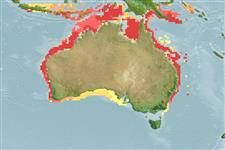>
Scombriformes (Mackerels) >
Scombridae (Mackerels, tunas, bonitos) > Scombrinae
Etymology: Cybiosarda: Greek, kybion = tunna + Latin, sarda = sardine (Ref. 45335).
More on author: Whitley.
Environment: milieu / climate zone / depth range / distribution range
Ecologia
marinhas; oceanódromo (Ref. 51243); intervalo de profundidade 50 - ? m. Tropical; 6°S - 41°S, 108°E - 158°E (Ref. 168)
Western Pacific: restricted to the northern three quarters of Australia (absent from the south coast) and the southern coast of Papua New Guinea.
Tamanho / Peso / Idade
Maturity: Lm ? range ? - ? cm
Max length : 45.0 cm FL macho/indeterminado; (Ref. 168); common length : 35.0 cm FL macho/indeterminado; (Ref. 168); peso máx. publicado: 2.0 kg (Ref. 168)
Espinhos dorsais (total): 16 - 18; Raios dorsais (total): 17-19; Espinhos anais 0; Raios anais : 15 - 17; Vértebras: 47 - 48. This species is distinguished by the following characters: body moderately short and deep, strongly compressed; mouth moderately large with upper jaw reaching to hind margin of eye; 2 tooth patches on upper surface of tongue; 13-22 large, conical teeth on upper jaw, 10-17 on lower jaw; 12-15 total gill rakers on first gill arch; l28-33 laminae of olfactory rosette; interorbital width 23.9 to 31% of head length; D1 XVI-XVIII,17-19, dorsal fins close together, the first high anteriorly, soft rays followed by 8-10 finlets; A 15-17 followed by 6-7 finlets; pectoral fins short with 22-24 rays; interpelvic process small and bifid; body mostly naked behind the well-developed corselet except for a band of scales along bases of dorsal and anal fins and patches of scales around bases of the pectoral and pelvic fins; caudal peduncle slender, with a well-developed lateral keel between 2 smaller keels on each side; no swimbladder, spleen not visible in ventral view, concealed under liver; liver with an elongate right lobe and a short left lobe which tends to fuse with the middle lobe; vertebrae 22-24 + 23-26 = 47-48. Colour of belly light with several stripes reminiscent of those of the skipjack tuna, Katsuwonus pelamis; back deep blue covered with elongate black spots; first dorsal fin jet black anteriorly, white in the few last posterior membranes; anal and second dorsal fins yellow (Ref. 9684).
An epipelagic, neritic species that forms schools of several hundred individuals. Taken as bait for snappers by commercial fishers, and for marlins and sharks by sport fishers. Its meat is white and dry and is good when smoked or served steamed with moderately flavored white sauce.
Ciclo de vida ou comportamento de acasalamento
Maturidade | Reprodução | Desova | Ovos | Fecundidade | Larvas
Collette, B.B. and C.E. Nauen, 1983. FAO Species Catalogue. Vol. 2. Scombrids of the world. An annotated and illustrated catalogue of tunas, mackerels, bonitos and related species known to date. Rome: FAO. FAO Fish. Synop. 125(2):137 p. (Ref. 168)
Status na Lista Vermelha da UICN (Ref. 130435)
Ameaça para os humanos
Harmless
Uso pelos humanos
Pescarias: pouco comercial; peixe esportivo: sim; isca: usually
Mais informação
Nomes comunsSinônimosMetabolismoPredadoresEcotoxicologiaReproduçãoMaturidadeDesovaAgregação de desovaFecundidadeOvosDesenvolvimento dos ovos
ReferênciasAquaculturaPerfil para aquaculturaEstirpesGenéticaElectrophoresesHereditariedadeDoençasProcessamentoNutrientsConversão de massa
ColaboradoresFotosStamps, Coins Misc.SonsCiguateraVelocidadeTipo de nataçãoÁrea branquialOtólitosCérebrosVisão
Ferramentas
Relatórios especiais
Baixar XML
Fontes da internet
Estimates based on models
Preferred temperature (Ref.
123201): 20.7 - 27.6, mean 26 °C (based on 165 cells).
Índice de diversidade filogenética (Ref.
82804): PD
50 = 1.0000 [Uniqueness, from 0.5 = low to 2.0 = high].
Bayesian length-weight: a=0.00955 (0.00464 - 0.01966), b=3.05 (2.88 - 3.22), in cm total length, based on LWR estimates for this (Sub)family-body shape (Ref.
93245).
Nível Trófico (Ref.
69278): 4.0 ±0.7 se; based on size and trophs of closest relatives
Resiliência (Ref.
120179): Elevada, tempo mínimo de duplicação da população menor que 15 meses (Preliminary K or Fecundity.).
Fishing Vulnerability (Ref.
59153): Moderate vulnerability (40 of 100).
Nutrients (Ref.
124155): Calcium = 110 [58, 229] mg/100g; Iron = 1.89 [1.12, 3.14] mg/100g; Protein = 21 [20, 22] %; Omega3 = 0.332 [0.202, 0.541] g/100g; Selenium = 61.7 [31.4, 123.1] μg/100g; VitaminA = 29.8 [12.3, 77.0] μg/100g; Zinc = 0.916 [0.633, 1.352] mg/100g (wet weight);
